Piano voicing is the process of adjusting the density of the felts covering the hammers striking the string to produce a warmer or brighter tone.
Piano voicing is the process of adjusting the density of the felts covering the hammers striking the string to produce a warmer or brighter tone. In this video, we will see how a piano is voiced and hear what a difference it can make to the piano's overall sound. The featured piano is a Bösendorfer grand piano - a beautiful piano right out of the box, but every piano has thousands of moving parts, and getting each hammer to work just like the other hammers and to get the optimal tone takes time and the craftsmanship of an expert. In this video, we will actually hear the piano before it is voiced, then afterwards. Voicing begins with making sure that everything within the action is working at its best - the hammers strike the strings squarely, the action is well-adjusted, and the piano is in fine tuning. In this example, we wanted to accentuate the part of the piano's voice that is warm, with lots of expression when played softly. To accomplish this, a needle is used to soften the point of the hammer that strikes the string. Our technician is careful not to disturb the denser layer of felt beneath the surface. This helps to produce the more powerful tone a piano has when it's played with more force. Done carefully, this process will give the piano lots of color and expression when played softly, but it will also have plenty of power when the player asks for it.

